
Ever fantasized about being on top of the world? Geographically speaking, you have a few choices: northern parts of Canada, Greenland, Norway, or Russia. These are the only four countries where you can be close to the top of the world, and therefore close to the North Pole.
While a North Pole expedition would be the cherry on the cake, many of us can neither afford nor successfully complete such a strenuous endeavour. Getting to the most northern reaches of Canada, Greenland, or Russia will require a substantial amount of money, preparation, and determination. The best option is Norway, but we’re not talking about Norway in continental Europe. We are talking about the Norwegian islands at the most northern reaches of the planet.
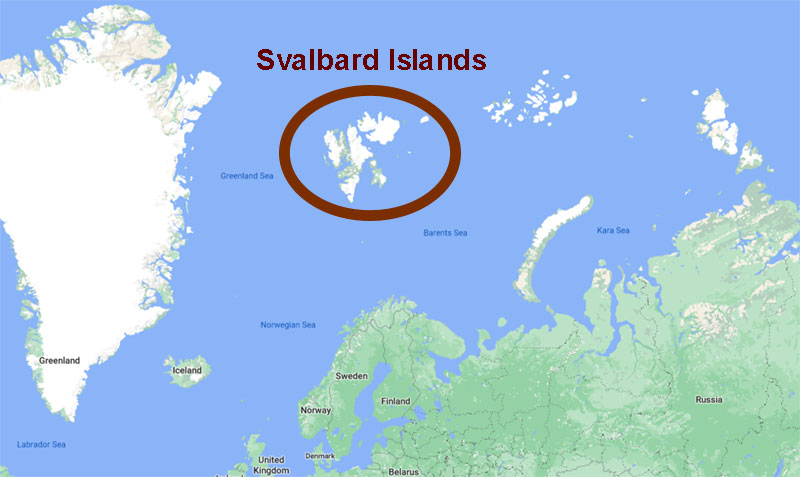
Why travel to the Svalbard Island?
- The low-down: The Svalbard Islands is a Norwegian archipelago located about midway between continental Norway and the North Pole. It is one of the world’s northernmost inhabited areas and is known for its rugged and remote terrain of glaciers and frozen tundra sheltering more than 3,000 polar bears.
- The brightest highlight: While the polar bears should be the focal point here, unless you come in summer and take a boat in search of them, you may not see them even though they may see you – especially in winter. Other highlights is the stunning natural scenery, in particular when you are exploring in winter by dog sled and snow mobile.
- Intrepid destination: Absolutely one of the very best intrepid destinations on the planet.
- Globerovers score (10 is highest): The Svalbard Islands gets a full score of 10 out of 10.

Table of Contents
Introduction to the Svalbard Islands
Welcome to the Svalbard Islands. Formerly known by the Dutch name of Spitsbergen, the group of Svalbard Islands (Spitsbergen being the largest), is a Norwegian archipelago in the Arctic Ocean. The name Svalbard means “cold coasts” which was first mentioned in Icelandic texts in the 12th century. The location of the islands ranges from 74° to 81° north latitude, and from 10° to 35° east longitude, and about 1,000 kilometres (621 mi) from the North Pole.
Located in the Arctic Ocean, halfway between Norway and the North Pole, the Svalbard Islands offer untouched arctic wilderness and unique wildlife.
These islands have a long history which includes the Norse, English, Danish, Dutch, Russian and French peoples. Following fierce claims of ownership by several nations, full sovereignty was granted to Norway in 1920 at the signing of the Svalbard Treaty in Paris, France. However, the treaty gave other signatory states, such as Russia, the right to engage in the exploitation of local natural resources.
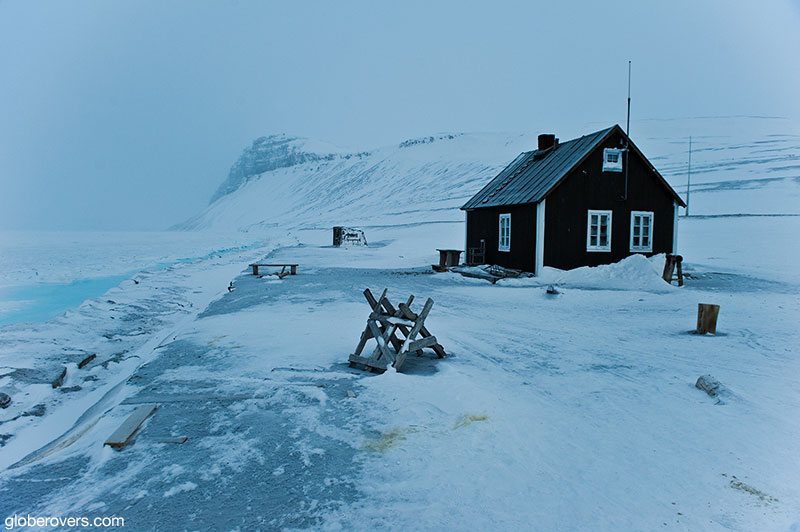
The resource-rich islands also have a history of walrus and whale hunting and extensive coal mining mainly by the Russians and their allies from the former USSR. Mining was established here during the 1920s, and it remains an industry to this day, albeit small. Norway recently declared their intent to close several of the remaining coal mines, followed by a cleanup of the surrounding areas. This will bring an end to the more than 100-year-long era of coal mining in Svalbard.
Nowadays, Svalbard is better known for scientific research, polar bear spotting, North Pole expeditions, and a few tourists who want to get close to the top of the world.
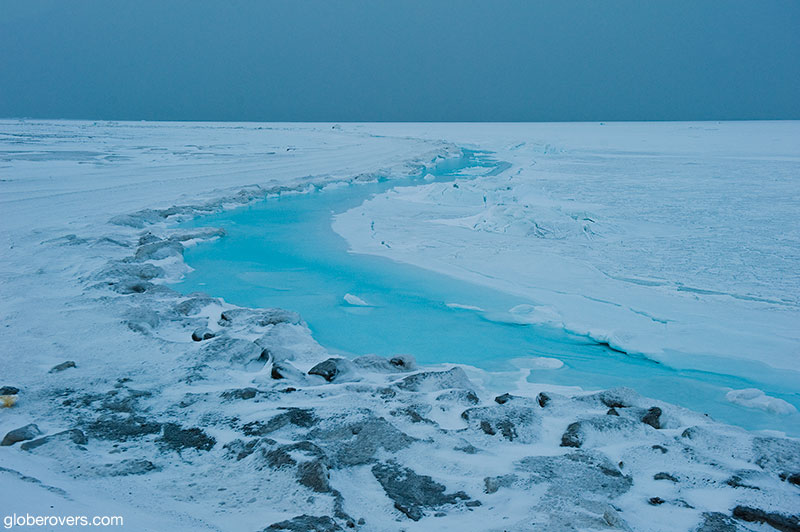
Svalbard is an all-year-round destination. Nearly 65 per cent of its surface consists of protected areas, including three nature reserves, six national parks and 15 bird sanctuaries.
The islands are also home to the Global Seed Vault which is located deep inside a mountain on Spitsbergen. Here the world’s largest diversity of crop seeds are protected in the event of loss of seeds in other genebanks during large-scale regional or global crises.
Located far north of the Arctic Circle, it experiences the midnight sun which lasts from mid-April until mid-August. This means no darkness for about 100 days. Winter, on the other hand, is bitterly cold when the polar night of darkness starts towards the end of October and lasts till mid-February.
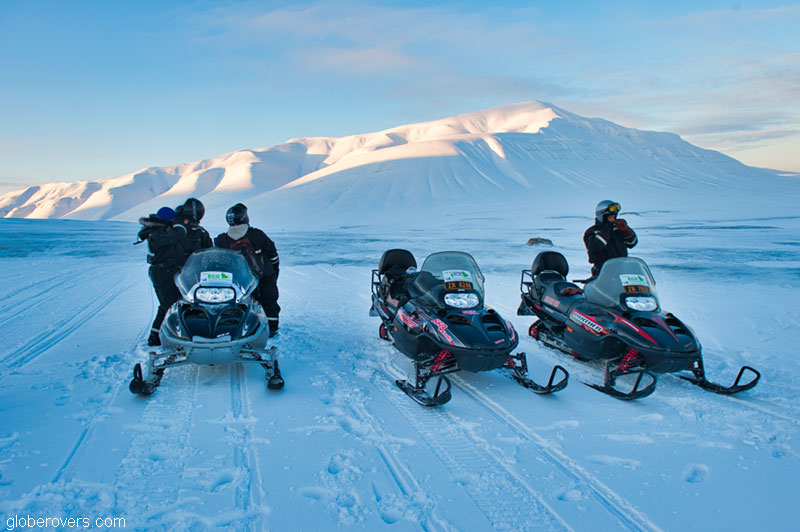
Svalbard is an amazing sight during winter. Everything is white, covered in snow and ice. The best time to visit during the winter period is from late February to late March when winter is still in full force but the total darkness has given way to some light on the southern horizon.
Come along and spend a few days on Spitsbergen, the largest and only permanently populated island of the Svalbard archipelago. While based in the small town of Longyearbyen, it is easy to take day trips with the husky dogs and snowmobiles while looking for polar bears, go ice caving, and have a hot chocolate inside the Noorderlicht sailboat lying frozen in Templefjorden.

Longyearbyen
Longyearbyen, the administrative centre of Svalbard, is a lively Arctic cosmopolitan settlement on Spitsbergen Island with about 2,100 residents hailing from almost 50 different countries. While most (76%) are Norwegian, you will also find some Swedes, Danes, Russians, Ukrainians, Germans, Americans, Thais, and many other nationalities.
World’s northernmost settlement of any kind with more than 1,000 permanent residents.
Most of its residents are scientists and nature enthusiasts who live in close unity under tough climatic conditions. Those who are not directly involved in scientific research, are somehow involved in the science community, tourism industry, or supporting services such as retailing, banking, education and medical.

Serving as the gateway to the High Arctic wilderness, Longyearbyen is also where tourists base themselves for day trips and multi-day trips into the Arctic landscape that virtually starts right outside of town and continues into the abyss. In rare instances, the wilderness, in the form of polar bears, even comes to roam around town.
While the town is tiny, it features everything needed by the residents and the small but growing tourist population. The range of services on offer to residents and tourists is surprisingly extensive, and includes a medical clinic, primary and secondary schools, a small research university with about 300 students, sports centre, a shopping mall, library, culture centre, cinema, a supermarket, hotels and guest houses, a bank, restaurants and bars, and even a few museums and galleries. In addition, you will also find a local brewery for fresh beer, a chocolaterie, and greenhouses that supply fresh herbs and vegetables in winter.
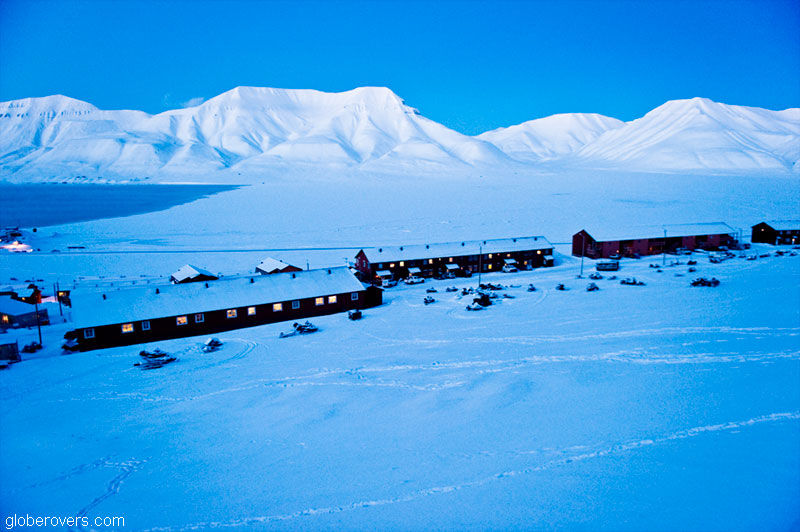
In mid-winter, February, the temperature in Longyearbyen varies from -30°C to -15°C (-22°F – 5°F) while the windchill can drop the thermometer down to -40°C (-40°F). While winters are dark and bitterly cold, life does not stand still here. Among the popular winter activities are walking through glacier caves, snowmobile riding, cross-country skiing, and dog-sled safaris. All activities can easily be arranged from agencies in town.
Cold winter nights are also a good time for spotting the spectacular Aurora Borealis, or Northern Lights, dancing across the skies. As winter nights are bitterly cold, you are in for a cold night outside while waiting for the lights to flare up. However, once they start to dance across the night skies, you will realise it was worth the long cold wait.
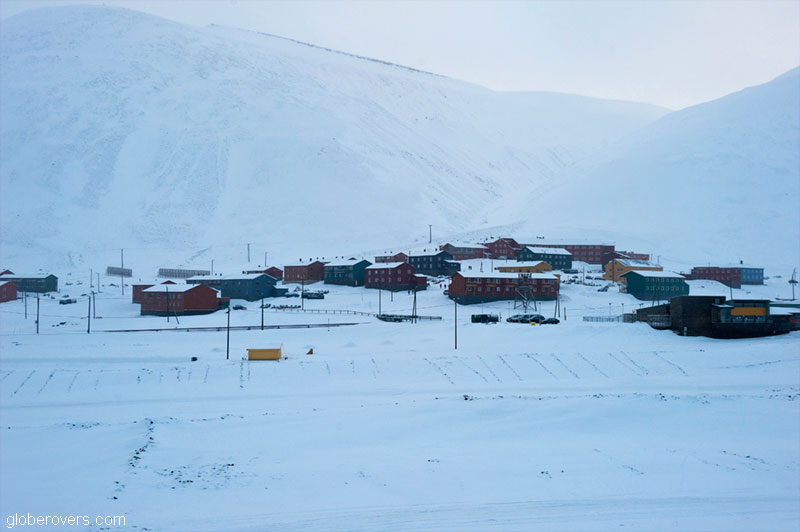
Longyearbyen is not the only settlement on Svalbard. The current permanent population across the islands is about 2,700 people, of which about 500 live in ethnic Russian and Ukrainian settlements. The majority of these are in Barentsburg and a few other residents in the largely abandoned coal mining settlement of Pyramiden.
Among the people living in the Russian settlements, the majority (75%) are Ukrainian, but there are also Russians and Tajiks. In addition, there are also a couple of souls living in very remote locations scattered across the islands, often in solitary confinement.

Dog Sledding
Dog sledding is arguably the most exciting winter fun activity that Svalbard offers. While the huskies so gently pull the sled across a snow-covered Arctic landscape, all you will hear is the sound of the eager dogs’ heavy breathing and the crunch of the sled sliding through the thick snow and patches of ice. Sit back and admire the white Arctic landscape on days of dim sunlight or even at night under the moonlight or beneath the magical Northern Lights.
Dog sledding on the Svalbard Islands is a day full of excitement. Let the dogs search for polar bears, but you’d better hope they don’t find them.
Tickets can be booked a day or two in advance at a travel agency in town. Depending on the company you booked with, early in the morning you will be taken about 5 km (3 mi) out of town to where the dog kennels are located.



On arrival at the kennels, you will meet the stars of the race. Each husky lives in its own raised wooden doghouse with its name proudly displayed above the entrance. Look out for Nanoq, Troika, Jokul, Franklin, Marfi, Truge, Martin, Hobbit, Gandalf and many more of their friends. While some dogs are shy and introverted, others will be exhilarated by your visit. Most of the dogs are adorable, and you will notice a few with deep blue eyes, even some with one brown and one blue eye.
Harness your dogs and head into the white horizons looking for polar bears.
Your guide will first introduce you to the principles of dog sledding and then carefully pick your six dogs. You will be trained to harness the dogs, and also to fit booties that protect their feet from the sharp ice. This is tricky as the dogs are overly excited to start running. Hold your dogs firmly, one at a time, and place the harness around the body and then clip the dog’s leashes (tuglines and necklines) to the mainline (gangline) that connects all six of them. Once your dogs are in place, you’d better immediately jump into your bucket-sled before the dogs leave without you!

With two people to a sled, one sits in the bucket or basket while the sledding partner, referred to as the musher, stands on the footboard at the back of the sled. The musher’s main purpose is to control the speed of the sled by stepping on the snow-brakes.
It is crucial to firmly control the dogs because when going downhill, they can reach dangerously high speeds. Without controlling the speed of the sled, it can travel faster than the dogs which could be catastrophic. In particular, on areas of hard ice, the sled can easily slide faster than the dogs can run. It is an eerie feeling when your bucket overtakes the dogs. I’ll never forget the way the dogs looked at my scared face when this happened to us.

In the unfortunate event that your bucket travels faster than the dogs and you can’t slow it down, you must ensure that you don’t run into the dogs from behind. Buckets don’t have steering wheels or any steering mechanism. The only way to steer is for both the musher and the person sitting in the bucket to wiggle the direction of the bucket with their weight.
If your bucket passes your dogs, and you can’t slow down with the snow-brakes, which come in many designs, some sleds have a second option called a claw-break. This type of brake is only used in an emergency and works like a ship’s anchor.

Tied to a short rope, when you plunge this iron claw into the snow, both the dogs and the sled will come to a rapid stop, which could injure man and beast alike. The final option to stop the running dogs is to deliberately topple your sled.
While this will bring the dogs to a halt, it is going to be a rather traumatic experience to all involved. Should you take this option and the bucket topples, make sure to cling on to the sled for dear life. If you don’t, the dogs most likely will keep running back to the kennels with the empty bucket in tow. You will then have to walk all the way back to the kennels where the dogs will be waiting.

On very cold days, you will also see the dogs are well prepared with their colourful booties, jackets, leggings, as well as belly raps for the females to protect their teats, especially if they recently gave birth, and male wraps for the males to protect their penises from getting frostbite.
Just to prove how cold it can get here, do the “snow-puff” test. Throw up a cup of hot water and see it literally exploding into drifting snowflakes.
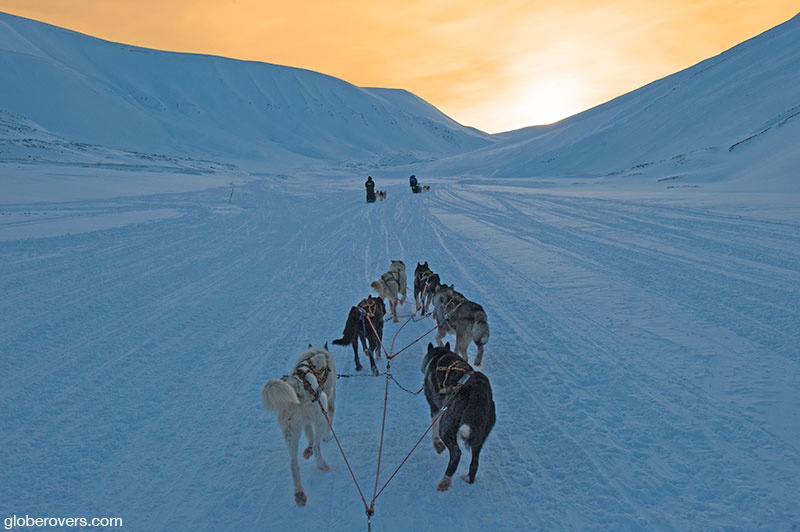
Ice Caving
Around 60% of the Svalbard archipelago is covered with glaciers. Svalbard is also home to Norway’s largest glacier, the Austfonna, which is the world’s third-largest ice cap after Antarctica and Greenland, with a circumference of 200 kilometres (124 mi). Located on the Island of Nordaustlandet it is 560 metres (1,837 ft) thick and the dome reaches an elevation of 783 metres (2,570 ft) above sea level.
Climb deep down into the jaws of the glaciers to see a surreal world.
Many of Svalbard’s glaciers contain endless passages formed by the melting waters in summer, creating impressive cathedral-like ice caves. When you walk on a seemingly flat plateau of snow and ice, it is hard to imagine that beneath you lies a frozen wonderland of endless caverns, tunnels, and frozen streams.
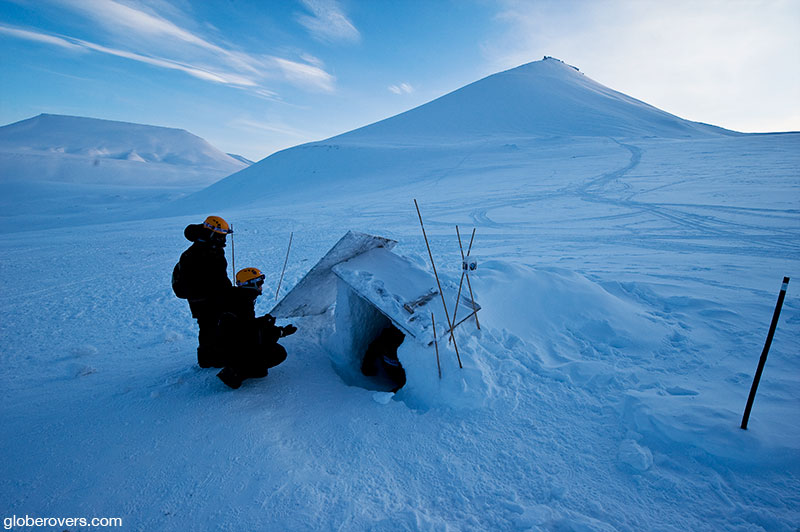
Equipped with a powerful headlamp, crampons and a helmet, it is possible to enter some of these caves. Ensure your guide offers crampons and a helmet as the frozen streams in the caves are very slippery. A slip and fall on the hard ice is not pleasant and can sometimes be fatal.
Entering some of the caves is not for the faint of heart. In some instances, you need to climb down a straight upright ladder and then slide down a short rope into what feels like an abyss.
The extremely cold climate means that Svalbard’s glaciers are solid and safe though caverns with stalactites form during the short summer months.
Just relax and enter this calm and deadly silent subglacial wonderworld to see the surreal, beautiful blue coloured stalactites, stalagmites, icicles and snow crystals. If you are lucky, you may even see 1,000-year-old remnants of frozen plants. If very lucky, you may just discover a frozen dinosaur fossil.
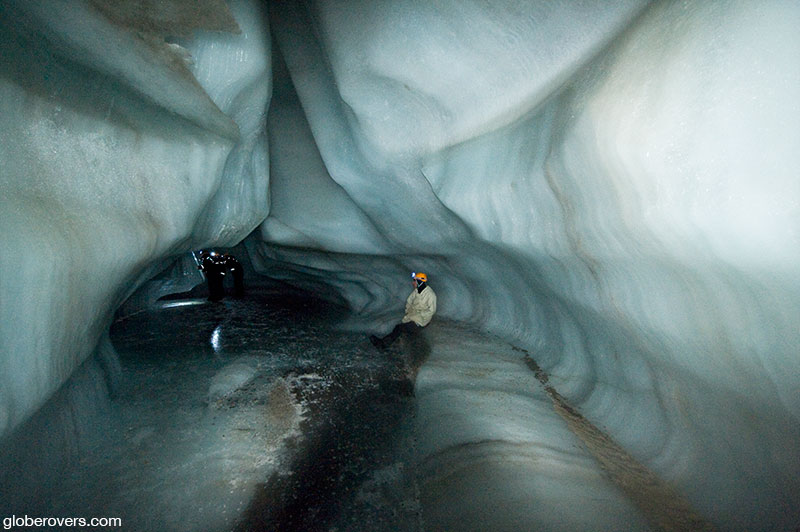
Turn off all man-made lights and you will be in complete darkness, the likes of which you may never have experienced.
Ice caving is often combined with dog sledding. Your team of eager huskies will take you over the vast white snow-covered horizons to the glaciers. They will wait patiently outside the cave entrance until you have finished exploring. Other options to reach the caves include driving by snowmobile right up to the entrance of the cave or being driven in comfort in a snowcat. If you are fit enough, get there by walking on your snowshoes, or by cross-country skiing.

While the temperature inside the cave is a balmy minus 2 degrees Celsius, on the surface it can go down to -30°C (-22°F), and much lower with the windchill factor. It is therefore essential to dress warmly.
The adventure travel operators in Longyearbyen are fully equipped so whether you travel by snowmobile, dog sled, or any other way, they have the right jackets and coverall jumpsuits to guard you against the extreme weather.

Polar Bear Spotting & Frozen Ships
While Svalbard is a land of glaciers and Arctic wilderness, it is also home to polar bears. Spotting the bears is not only the most exhilarating adventure on the islands, it is also the most dangerous.
Around Svalbard, polar bears are a real danger all year round. When you are travelling out of town you must be with a qualified guide who must, by law, carry a shotgun. Take this warning very seriously. Don’t even wander a little way out of town without someone carrying a gun. Even be careful around town at night. Some tourists have been eaten by hungry bears right in Longyearbyen, and also on the hills surrounding the town.
While there are about 3,000 bears on the islands, in winter you may not see any.
In winter there are at least 500 polar bears on the main islands of Svalbard and another 2,500 in the wider region which stretches all the way to the North Pole. However, to see polar bears in winter is like finding a needle in a haystack. Not only do the bears roam a very large area, but they are also perfectly camouflaged in surroundings almost entirely covered in snow and ice. If you are polar bear spotting in winter, the bears will most likely spot you without you knowing it. That could be fatal!

The east coast of Spitsbergen is generally colder than the west coast due to the distance from the gulf stream. This means more sea ice, more seals, and thus better conditions for polar bears. From Longyearbyen, we left early in the morning by snowmobiles and continued east through the Esker valley and out through the Sassen valley. After almost 200 km (124 mi), we arrived in Mohn Bay on the far east coast. Here we enjoyed a picnic lunch in front of the mighty glacier face, while all the time keeping our eyes peeled for any signs of polar bears.
Another good option during the winter months is to book a cabin in the 46 metre (151 ft) long steel-hulled Noorderlicht sailboat. Originally constructed in 1910 for the German Navy fleet as a three-masted schooner, in 1991 she was completely remodelled and refitted with two masts. Since then she has been operating as an expedition cruiser sailing to more remote Arctic locations, particularly around the Svalbard Islands.
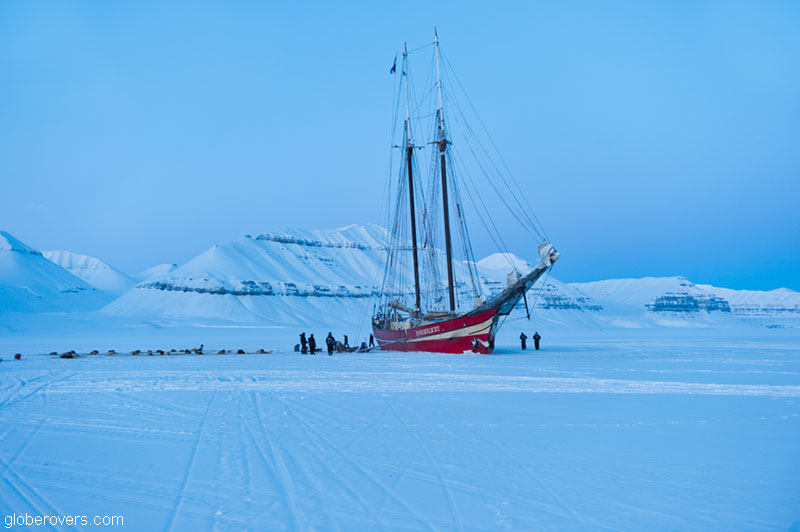
In winter, when much of the sea around the islands is frozen, she is intentionally frozen into Tempelfjorden, 30 km northeast of Longyearbyen. Here she peacefully serves as base-camp accommodation for Arctic voyages, and as a guesthouse for those who want to see the bears. She will wait here until the thawing of the oceans, at which time she will start cruising around the islands, fully booked with polar bear spotting teams.
The sailboat has 10 simple, but comfortable, twin cabins with upper and lower berths, a cupboard and washbasin. There are also four shared showers and toilets on board. It has a cosy communal area where delicious food such as freshly baked bread is served. From the comforts of the sailboat, keep your eyes peeled on the surrounding ice and snow of the fjord. If you are lucky, you may see a polar bear or two lured closer to the sailboat by the smell of fresh human flesh. Keep the doors locked!
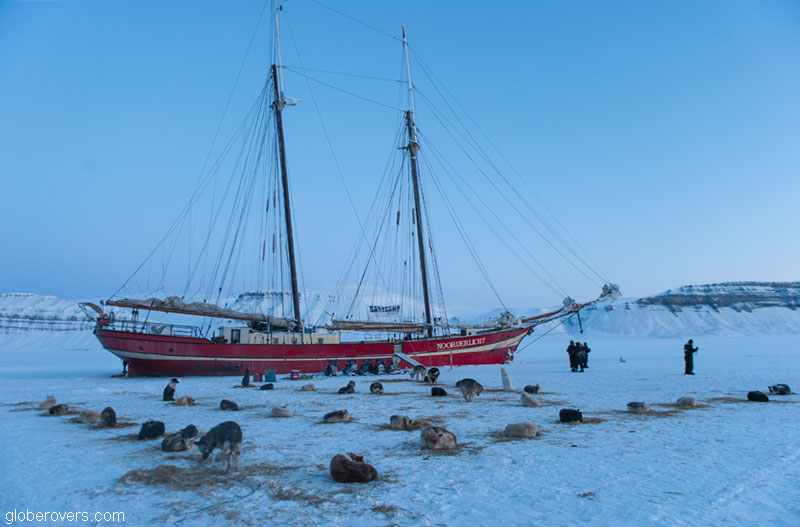
During some winter months, the Noorderlicht offers 7-day voyages from Tromsø, on the Norwegian mainland. During these voyages, passengers can admire the magnificent landscapes, wildlife, picturesque villages and beautiful Arctic Northern Lights. In winter, the fjords of the northern part of Norway are filled with various species of whales that feed on the herring and other fish.
From April until October during the 24-hours sunshine a day in the summer months, there is much less ice and snow so the bears congregate around the pack ice regions along the northern shores of Svalbard. This is the ideal time of the year to spot them, normally from a boat cruise, such as the Noorderlicht.

The Noorderlicht slowly cruises around the islands, in particular, the northernmost islands which are snow covered all-year-round and surrounded by ice, the ideal hunting place for bears. From the sailboat, the bears can easily be spotted, although she has 2 rigid-hulled inflatable boats on board to be used for landings and for wildlife watching in inaccessible areas. In addition to the bears, look out for Arctic fox, reindeer, whales, walrus, seals, and rare bird species such as the ivory gull, the little auk, and the puffin.
Another good option in summer is to stay in a luxury lodge perched at the edge of the magnificent Nordenskiöld glacier. The Nordenskiöld glacier is part of the larger glacier system stretching all the way to the north coast of Spitsbergen Island.
The Nordenskiöld Lodge, with its expedition cabins, offers wildlife spotting excursions, including for polar bears. Enjoy summer dog sledding and then join a boat expedition around the coast to spot walruses, whales, and polar bears along the shores.
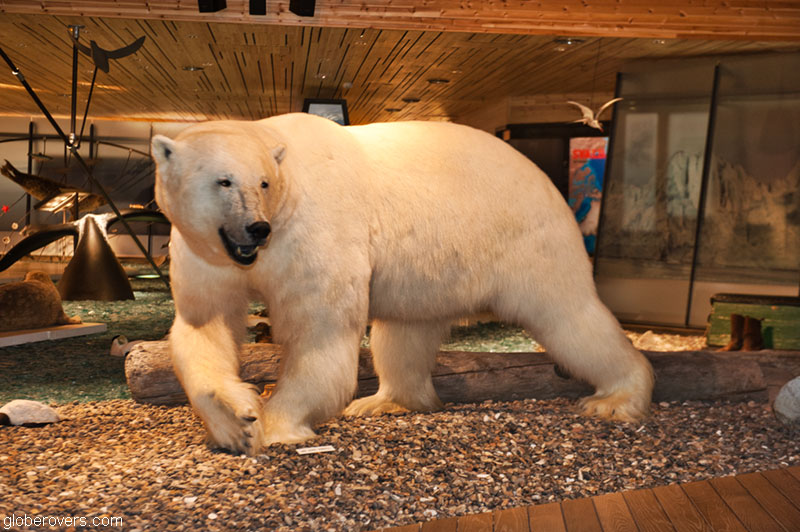
Other adventures offered by the lodge include guided glacier climbs, kayaking, and sightseeing. At the end of the day, relax in a steaming hot sauna! In summer, the lodge is reached by the 12-person Polarcirkel boat, and in wintertime, you will arrive on your own snowmobile across frozen fjords and mighty glaciers.
The lodge offers 5 bedrooms, all with great Arctic views, ten comfortable beds, an indoor toilet, and a traditional wood sauna. Don’t expect running water or electricity, and get your drinking water by melting ice from the glacier. A true adventure.
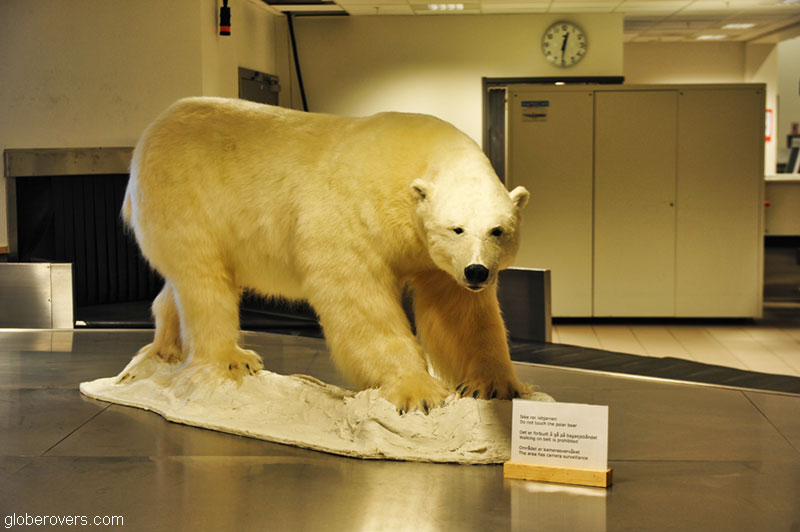
☛ Read more: Blog posts of Winter Wonderlands



Blog post and photos by Peter who has been travelling almost full-time since 2005 and has been to over 122 countries. He visited several countries, such as Japan, more than 20 times. Peter is Editor-in-Chief and Publisher of GlobeRovers Magazine, an independent travel magazine focused on intrepid destinations.
